
With a population of over 250 million, big companies have their eyes set on Indonesia.
Statistics show that the total number of mobile phone users for 2017 is expected to rise to a whopping 173 million, making this country an attractive territory for mobile marketing.
But while Indonesia is a promising market because of the density of its consumers on mobile, geography is a hurdle for all marketers.
With over 17,000 islands and more than 726 dialects spoken across the archipelago, how can brands reach this seemingly fragmented audience?
Understanding the content Indonesians prefer on mobile is needed to connect with these consumers.
A report published by Jakpat, a mobile survey provider in Indonesia, revealed the top daily activities on mobile include social media, chatting, listening to music and gaming.
In the 16 - 19 year-old age bracket, 59.56% listen to music daily on their smartphone, compared with 51% of the 20-35 year-old group.
Because music is so engaging on mobile, there is no doubt that brands can use it as a universal language to break down dialect barriers and be a part of Indonesians’ daily routines.
Tuned Global used the Jakpat platforms to conduct a study on 504 smartphone owners in Indonesia to understand how they stream music on mobile. The respondents were aged 18 - 29 years, with an equal representation of men and women.
Read about our key findings as outlined below.
How many hours per week do you stream music online on your mobile?
The majority of Indonesians are streaming 1 - 6 hours per week of music on their mobile. An average of 2 hours of listening per week for 61% of streamers.
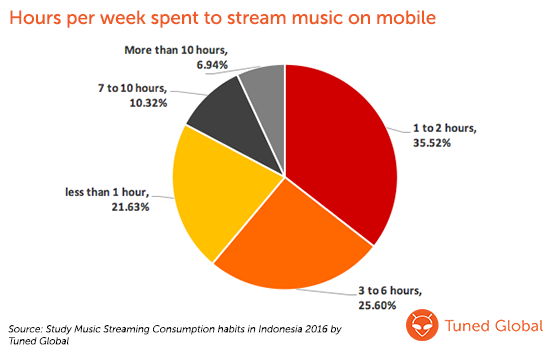
This finding is consistent with the conclusion of the Jakpat report that Indonesians listen to music on their mobiles on a daily basis as part of their digital pleasure fulfilment.
What are the 2 main constraints that keep you from streaming more music on your smartphone?
Indonesian streamers would love to stream more music but their main barrier is low connectivity throughout the country and the high cost of Internet data.
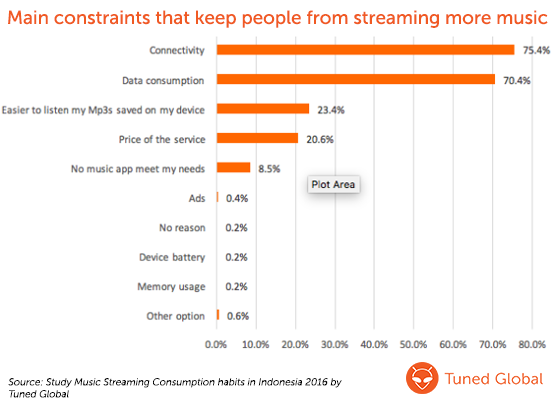
In another report by Redwing, it was revealed that of the 278 million mobile subscribers, 98% are pre-paid users and how many subscribers hold two or three active SIM cards – and often own two or three phones.
People do this in order to find the best signal quality or the cheapest prices. The challenge for Indonesia’s telco providers is how to drive the growth of data subscribers and the associated data revenues.
People in these markets are clear that they value low bandwidth usage more than high audio quality which influences music app providers to improve their caching systems whilst ensuring they are providing low bandwidth options to users.
What are your 3 favourite moments to stream music online on your smartphone?
Music is for the majority of respondents a way to relax alone after a long day of working or being by the beach.
In second place, streamers listen to music when they are busy with their daily chores, including cleaning and cooking. Music is a companion for people when they are reading, working, commuting or training.
In the end, music is also a great way to socialise with friends.
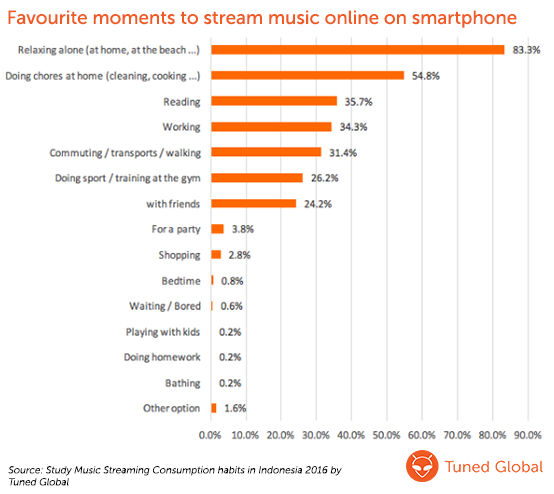
Listening to music to perk up daily routines is not surprising.
Research published in PLOS ONE showed that even sad music can lift your mood, whilst another study reveals how music can boost happiness and reduce stress and anxiety levels.
“The results help us to pinpoint the ways people regulate their mood with the help of music, as well as how music rehabilitation and music therapy might tap into these processes of comfort, relief, and enjoyment,” says Tuomas Eerola, Ph.D., and professor of music cognition at Durham University.
Do you stream music on your mobile when you have a wi-fi connection or use your mobile data?
As we have stated previously, the cost of data consumption is a main concern for Indonesians while streaming music.
The majority of people stream music by switching from wi-fi to mobile data throughout the day, depending on where they are. And have formed the habit of switching from mobile to a wi-fi connection to save a few gigs.
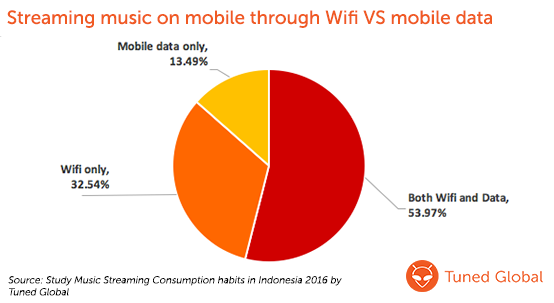
Indonesians who want to save their data have to be resourceful in their mobile app usage.
Malls are incredibly important places in Indonesia as they have become the public meeting places of choice for Millennials for a few reasons. Most Indonesians like to socialise at malls and lastly, the mall offers free wi-fi.
It is not rare to see a group of friends sitting around at the mall while conversing with a mobile phone in hand and streaming their favourite music.
How often do you stream music on your computer?
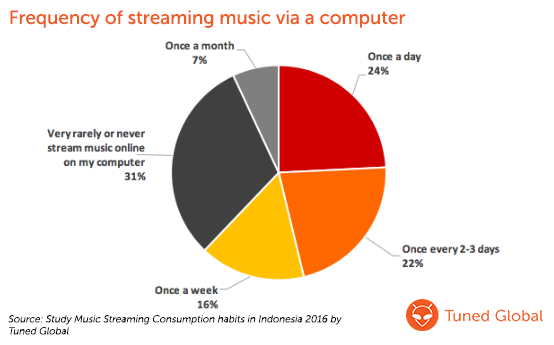
Even though Indonesia is a mobile-first country, 62% of streamers will at least listen to music on their computer once a week, with 46% of respondents streaming music more than 2 times a week on a desktop.
In conclusion, music is a daily companion for Indonesian people who enjoy streaming music on their smartphones on average 2 hours per day, mainly when they get a wi-fi connection to save their mobile data.
At the same time, marketers are searching for innovative solutions to engage their customers on mobile in a country where 300 different native languages are spoken.
Could music become the universal language that connects people and brands?
This is one of the reasons we launched Nada Kita in Indonesia, a 100% free music app that gives users unlimited free access to the sounds of their favourite local music artists without consuming a lot of mobile data.
We give brands the opportunity to use Nada Kita to create innovative and meaningful connections with Indonesian consumers.
If you found value or insight from this post, please consider sharing it on Twitter or Linkedin. Thanks for reading!
Follow Tuned Global and always be in the know.
Follow @TunedGlobal



